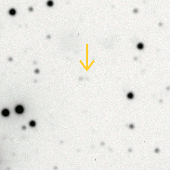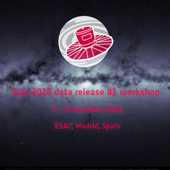ESA Science & Technology - News Archive
News archive
News archive
The first data release of ESA's Gaia satellite provided a surprising number of scientific results. Yet it is nothing but a tease for what is expected from the second data release, scheduled for 25 April.
Published: 20 April 2018
Media representatives are invited to a briefing on the second data release of ESA's Gaia mission, an astrometry mission to map more than one billion stars in our Galaxy, the Milky Way. The media briefing is being organised by ESA at the ILA Berlin Air and Space Show in Germany, on Wednesday 25 April 2018.
Published: 19 April 2018
As astronomers worldwide are preparing to explore the second data release of ESA's Gaia satellite, the Data Processing and Analysing Consortium announced just how many sources will be included in the new catalogue, which will be made public on 25 April.
Published: 5 April 2018
While charting the positions of more than a billion stars, ESA's Gaia mission provides all-important information even about the dark patches of the sky where fewer stars are observed. These images, based on Gaia's first data release, are an appetizer to the astronomical riches that will be unleashed with the mission's second release on 25 April.
Published: 3 April 2018
Last month, ESA's Gaia satellite experienced a technical anomaly followed by a 'safe mode' event. After thorough examination, the spacecraft was successfully recovered and resumed normal scientific operations, while the mission team keeps investigating the exact cause of the anomaly.
Published: 21 March 2018
Last year, ESA's Gaia mission helped astronomers make unique observations of Neptune's largest moon, Triton, as it passed in front of a distant star. This is a preview of the superb quality and versatility of the Gaia data that will be released in April.
Published: 27 February 2018
Following the release of the first catalogue in 2016, ESA's Gaia mission will publish its long-awaited map of more than 1 billion stars in our Galaxy on 25 April 2018.
Published: 25 January 2018
Measuring the positions and motions of more than a billion stars, ESA's Gaia mission will refine our knowledge about our place in the Universe, providing the best ever star chart of our Milky Way and its neighbouring galaxies.
Published: 13 December 2017
By pinning down, for the first time, the three-dimensional motions of individual stars in the nearby Sculptor dwarf galaxy, astronomers have shed new light on the distribution of invisible dark matter that pervades the galaxy.
Published: 27 November 2017
It's the perfect meeting of old and new. Astronomers have combined the latest data from ESA's Gaia mission with a simple analysis technique from the 18th century to discover a massive star cluster that had previously escaped detection. Now, subsequent investigations are helping reveal the star-forming history of our Galaxy, the Milky Way.
Published: 15 November 2017
On 5 October 2017, the largest moon of Neptune will pass in front of a distant star. This rare event will temporarily block the star's light from Earth and provide an excellent opportunity to study the moon's intriguing atmosphere. Data from ESA's Gaia mission is allowing astronomers to precisely plan their observations.
Published: 3 October 2017
The movements of more than 300 000 stars surveyed by ESA's Gaia satellite reveal that rare close encounters with our Sun might disturb the cloud of comets at the far reaches of our Solar System, sending some towards Earth in the distant future.
Published: 31 August 2017
While surveying the positions of over a billion stars, ESA's Gaia mission is also measuring their colour, a key diagnostic to study the physical properties of stars. A new image provides a preview of Gaia's first full-colour all-sky map, which will be unleashed in its highest resolution with the next data release in 2018.
Published: 16 August 2017
With the help of software that mimics a human brain, ESA's Gaia satellite spotted six stars zipping at high speed from the centre of our Galaxy to its outskirts. This could provide key information about some of the most obscure regions of the Milky Way.
Published: 26 June 2017
A new video, based on measurements by ESA's Gaia and Hipparcos satellites, shows how our view of the Orion constellation will evolve over the next 450 000 years.
Published: 9 June 2017
While compiling an unprecedented census of one billion stars in our Galaxy, ESA's Gaia mission is also surveying stars beyond our Milky Way. A new image of M33, also known as the Triangulum galaxy, shows tens of thousands of stars detected by Gaia, including a small stellar census in its star-forming region NGC 604. This is a striking example of...
Published: 20 April 2017
The changing face of our Galaxy is revealed in a new video from ESA’s Gaia mission. The motion of two million stars is traced 5 million years into the future using data from the Tycho-Gaia Astrometric Solution, one of the products of the first Gaia data release. This provides a preview of the stellar motions that will be revealed in Gaia's...
Published: 12 April 2017
Whilst best known for its surveys of the stars and mapping the Milky Way in three dimensions, ESA's Gaia has many more strings to its bow. Among them, its contribution to our understanding of the asteroids that litter the Solar System. Now, for the first time, Gaia is not only providing information crucial to understanding known asteroids, it...
Published: 24 January 2017
On 2-4 November, the European Space Astronomy Centre near Madrid, Spain, will host the Gaia 2016 Data Release #1 Workshop. Many of the talks will be broadcast live.
Published: 28 October 2016
While scanning the sky to measure the position of over one billion stars in our Galaxy, ESA's Gaia satellite has detected two rare instances of stars whose light was temporarily boosted by other celestial objects passing across their lines of sight.
Published: 27 October 2016
—
20 Items per Page




















